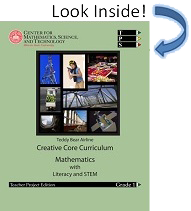First Grade Mathematics 
Operations and Algebraic Thinking and Measurement and Data
Teddy Bear Airline
Each student brings a "Beanie Baby" or other small stuffed animal to class. The teacher has a few extras in case students do not have one. They make luggage from construction paper so they have objects to measure. The amount of area needed for each animal is measured and added to determine total area needed. The animals are placed in two rows, like airplane seats, on a large piece of cardboard. They can draw around them to identify seating area. More measurements can be taken. Luggage is stacked in various ways to provide more opportunity for measurements and predictions can be made about total area needed. They draw an airplane around the passenger area and can make it 3-dimensional using cardboard, foam, tape, etc.
Students decide where they want to go based on what sites they want to visit. They identify the cities on a map. Students cut paper drywall tape to the distance between cities and write a letter on each piece. They can lay the pieces end to end to make a formula (A+B+C+D=X) and measure total distance. They can also rearrange the pieces (D+C+B+A=X) to see that the total length is the same regardless of order of operations. The airplane takes off (leaves the room). Students get photo updates during the trip from a sneaky parent with photo editing software. When the trip is done, the plane returns to the classroom. All the animals have t-shirts, passport stamps, cities listed on their luggage, etc.
Numbers of Operations in Base Ten
Harvest Time
Students build trucks from milk cartons. They use these trucks to haul produce from a field to the storage area. They are in bundles of 10. They rebundle the produce into larger groups and haul them to another location for sale. Sale prices are based on certain sized bundles so additional work with base-10 is possible. The items are eventually loaded on a train or ship in still another size bundle (more base-10).
Geometry
Toothpicks and Marshmallows
Each student is given several toothpicks and marshmallows. They make geometric shapes, tracing them on paper and labeling each with the proper name. Eventually the shapes become 3-dimensional.

